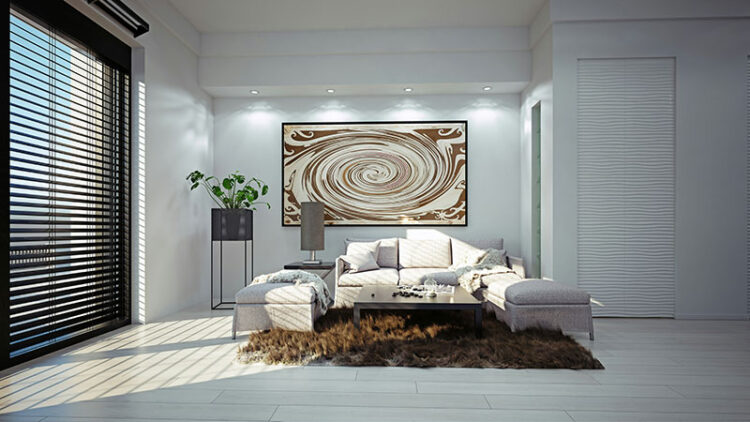Window treatments do more than cover glass and block the sun. They bring style and function together, shaping how a home feels and works day to day. Alex Chubbuck, the Director of Skyline Interiors, a professional window treatment installation company based in Philadelphia, explores choosing the right window treatments for any space.
With so many options available, finding the right match for each room is key. A smart choice balances privacy, light, insulation, and the look of the space. Understanding how to select the ideal window treatments for any room requires examining style, comfort, and practicality.
Understanding Window Treatment Options
Window treatments fall into several main types, each with its own strengths. Blinds use adjustable slats, allowing the homeowner to change light and privacy with a quick tilt. They come in various materials like wood, faux wood, and aluminum, which suit different styles and budgets.
Curtains, sometimes called drapes, hang in fabric panels. They offer softness and color while controlling light and adding texture. Choices range from sheer panels that let in light to heavy blackout drapes for full privacy.
Shades operate as a solid piece rather than slats or panels. Roller shades, Roman shades, and cellular shades each bring a different look and level of insulation. Cellular, or honeycomb, shades add an extra layer of insulation due to their unique structure.
Shutters, mounted inside the window frame, offer a classic look and strong control over light and air flow. They work well in most rooms and last for years. The choice impacts the room’s privacy, light levels, and insulation.
Thick fabrics or multi-layer shades work best for blocking light and sound. Lighter treatments allow daylight to filter in while maintaining a measure of privacy. Some higher-end options feature built-in insulation or UV protection, helping keep energy bills down and fabrics from fading.
Tailoring Window Treatments to Each Room
“Each room in a home has different needs,” says Alex Chubbuck. “The traffic, use, and exposure of a space help determine which window treatment works best. Style choices should support the way a room feels while staying practical for the setting.”
The living room ties the home together, serving as a place for both relaxation and entertaining. For this space, layering can add depth and flexibility. Pairing sheer curtains with drapes or blinds offers control over natural light and privacy throughout the day. Homeowners often select neutral or soft colors to keep a welcoming, open feel. Materials like linen or light cotton add warmth without making the room feel heavy.
Large windows call for treatments that frame the view without blocking it. Floor-length curtains or vertical blinds help create a sense of height and grandeur. For rooms that face the street, privacy sheers allow some view outside while keeping prying eyes away. For a more formal style, consider heavy drapes in rich colors, but pair them with lighter sheers underneath to soften the effect when open.
In bedrooms, privacy and comfort take priority. Blackout curtains or shades keep unwanted light out during sleep hours. They work especially well in city settings or homes with early sun. Layering is common, with a sheer base for light filtering and a thicker layer for blocking light and sound.
Roman shades and cellular shades both suit bedrooms, as their smooth lines keep the room calm and uncluttered. Color choices in bedrooms often reflect a sense of calm and relaxation. Soft blues, grays, and creams promote restfulness. Textured fabrics add a tactile sense of warmth. For children’s bedrooms, cordless blinds or shades reduce the risk of accidents and make operation simpler.
Kitchens and bathrooms face more moisture, heat, and changes in air quality than most rooms. Treatments in these spaces must handle these conditions without warping or discoloring.
“Faux wood blinds or aluminum blinds work well, as do vinyl shutters,” notes Chubbuck. “These materials resist moisture and wipe clean without fuss.”
In kitchens, simple roller shades or flat Roman shades stay out of the way and clean up quickly. Gentle colors and slim profiles help keep the space looking fresh and bright. In bathrooms, options that allow for privacy without trapping moisture are key.
Frosted shades, waterproof shutters, or cafe curtains hung halfway up the window let in daylight but block direct views. Light, water-resistant materials work best, as they stand up over time and need less upkeep.
Expert Tips for Choosing and Installing Window Treatments
A good result starts with careful measurements. Measure the width and height of each window, noting any trim or unusual features. Decide whether to mount the treatment inside the frame for a clean look or outside to make the window seem larger. Double-checking all measurements before ordering as an inch off can mean treatments that do not fit or do not look right.
Choose colors and fabrics that blend or contrast well with other decor. Neutral shades keep the room balanced, while bold colors or patterns add character. Fabrics range in weight and texture, from light sheer linen to heavy velvet. Pick lighter materials for kitchens and bathrooms, and richer fabrics for formal spaces.
Installation must be safe and stable. Secure mounting hardware into wall studs or masonry, not just drywall. Cordless lifts and wands reduce risks, especially for homes with young children or pets. Make sure to keep cords short and tidy or use motorized controls for extra safety and ease.
Window treatments work best when chosen with the room’s use in mind. Homeowners often underestimate the value of quality fabric or the right style of blind, but these details shape daily life.
“Avoid pitfalls like hanging curtains too low, picking fabrics that fade quickly, or mismatching colors with wall paint. Instead, look for treatments that fit the proportions of the window and complement other soft furnishings,” says Chubbuck.
For homes with pets or allergies, easy-to-clean options like synthetic shades or washable curtains prove practical over time. Always check cleaning instructions before committing to a type or style, as some fabrics need professional care. Durability often comes from stronger materials and well-built mechanisms. No one wants to replace blinds every year.
Choosing window treatments calls for consideration of both style and function. The right selections support privacy, let in the right amount of light, and add character to every room. By matching window treatments to each space’s purpose and conditions, homeowners create comfortable, stylish rooms that feel complete.
Smart choices with color, material, and installation promise long-lasting results and improve day-to-day life. A thoughtful approach to window treatments makes a noticeable difference, turning windows from empty frames into highlights of the home.













